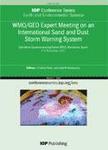版权所有:内蒙古大学图书馆 技术提供:维普资讯• 智图
内蒙古自治区呼和浩特市赛罕区大学西街235号 邮编: 010021

作者机构:Department of Chemical Engineering Fajar University Makassar South Sulawesi Indonesia Program of Infrastructure and Environmental Engineering Fajar University Makassar South Sulawesi Indonesia Department of Mechanical Engineering Fajar University Makassar South Sulawesi Indonesia Academy of Midwifery of Tahirah Al Baeti Bulukumba District South Sulawesi Indonesia Research Center for Brackish Aquaculture Fisheries and Extension Fisheries Maros District South Sulawesi Indonesia
出 版 物:《IOP Conference Series: Earth and Environmental Science》
年 卷 期:2021年第737卷第1期
摘 要:The purpose of this research is to understand sponge species, micro symbiont, performance, mechanisms, and types of compounds resulting from biodegradation. The analytical method is applied by selecting the model, results from characterization and morphological identification, phenotype, genotype. Selected of micro symbiont are made as suspensions, interacted with modified naphthalene contaminated waste. The biodegradation process using the Bacillus Sp (BS) isolates sponge Neopetrosia Sp and Acinetobacter Calcoaceticus (AC) isolated from sponge Callyspongia Aerizusa, was carried out by interacting a microscopic suspension of 5,000 mg/L naphthalene waste for 25 days. Micro symbiont biodegradation results by determining the concentration of contaminants and biodegradation products, in the form of pure organic compounds using GC-MS, and the analysis of functional groups of natural components using IR. Destruction of the naphthalene molecule occurs through an enzymatic reaction mechanism, observed based on visible parameters. The performance of BS symbiont biodegradation on naphthalene is in the range of 7.34% - 51.37%, while the AC range is 5.84% -37.26% in w/v, achieved within 5-25 days interaction. Biodegradation products based on functional groups were identified as compounds of aldehyde, ketone, carboxylic acids, esters, alkanes. Observation of biodegradation parameters confirmed pH changes, increased optical density values, gas bubbles formed and the smell of fermentation.